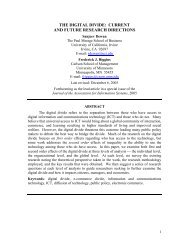Agent-Based Modeling to Inform Online Community Theory and ...
Agent-Based Modeling to Inform Online Community Theory and ...
Agent-Based Modeling to Inform Online Community Theory and ...
Create successful ePaper yourself
Turn your PDF publications into a flip-book with our unique Google optimized e-Paper software.
2.1.1. Which messages <strong>to</strong> read? Typically, a member views messages in reverse chrono-<br />
logical orders <strong>and</strong> s<strong>to</strong>ps viewing when he runs out of time, interest, or messages. We assume that<br />
the <strong>to</strong>tal number of messages a member views on a particular day depends upon the <strong>to</strong>tal number of<br />
messages available that day <strong>and</strong> how motivated the member is <strong>to</strong> read. We calculate messages an<br />
agent will view on a specific day as proportional <strong>to</strong> the amount of benefit he has received in the<br />
past from reading messages, capped by the <strong>to</strong>tal number of messages available <strong>to</strong> read. Because<br />
most people read in reverse chronological order <strong>and</strong> messages get stale with time, members are<br />
more likely <strong>to</strong> view <strong>and</strong> respond <strong>to</strong> recent messages (i.e., messages posted within a day or so) <strong>and</strong><br />
have a lower probability of reading older <strong>and</strong> less active messages (Arguello et al. 2006, Kalman et<br />
al. 2006) . To post a message, an agent makes three additional decisions: (1) whether <strong>to</strong> start a new<br />
thread or reply <strong>to</strong> an existing post; (2) the <strong>to</strong>pic of the message, if starting a new thread <strong>and</strong>, (3)<br />
which message <strong>to</strong> respond <strong>to</strong>, replying. For simplicity, we assume that the agent is equally likely <strong>to</strong><br />
start a new thread or <strong>to</strong> reply <strong>to</strong> an existing thread, <strong>and</strong> sensitivity analyses indicate that our results<br />
remain robust when we vary the percentage of starting a new thread from 30% <strong>to</strong> 70%.<br />
2.1.2. What is the <strong>to</strong>pic? A movie discussion community can be organized broadly, wel-<br />
coming any movie-related <strong>to</strong>pics such as movie genres, critics <strong>and</strong> celebrities, or more narrowly<br />
around a single <strong>to</strong>pic, such as fantasy movies or Harry Potter. A member can be interested in one<br />
or more of the <strong>to</strong>pics. We assume that members’ interests remain static <strong>and</strong> do not change during<br />
the experimental period. We assume that each message concerns only one <strong>to</strong>pic, although the analy-<br />
sis is the same if each message refers <strong>to</strong> several <strong>to</strong>pics. When an agent posts a thread-starting mes-<br />
sage, the <strong>to</strong>pic of this message is a joint function of the agent’s interests <strong>and</strong> the <strong>to</strong>pics of messages<br />
the agent has recently viewed, <strong>to</strong> account for social influence. When an agent posts a reply, the<br />
<strong>to</strong>pic is a joint function of the <strong>to</strong>pic of the replied-<strong>to</strong> message, the agent’s interests <strong>and</strong> <strong>to</strong>pics of<br />
messages the agent has recently viewed. Thus, a fantasy movie lover is likely <strong>to</strong> initiate or reply <strong>to</strong><br />
messages about fantasy movies, <strong>and</strong> this tendency will be greater in a fantasy movie discussion<br />
forum than in a general movie forum. In communities with little off-<strong>to</strong>pic discussion, members are<br />
12
















